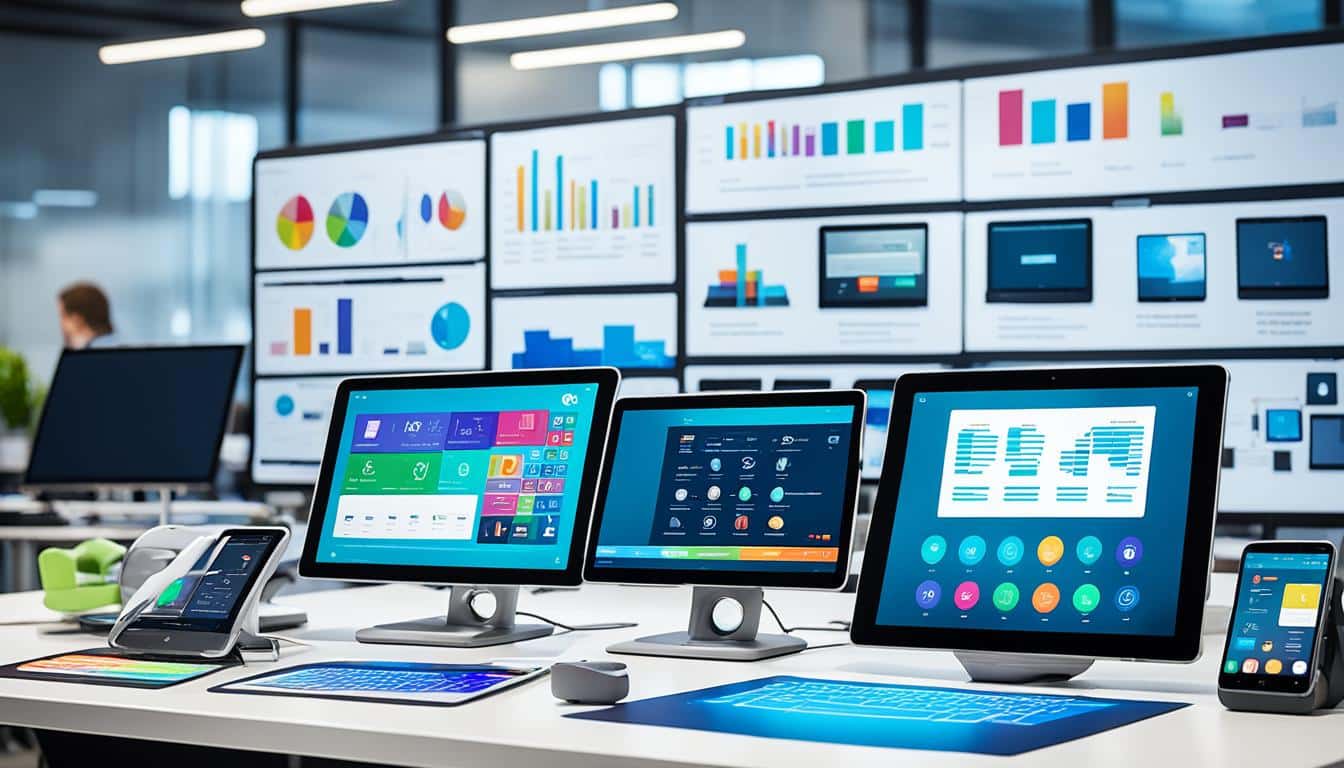Technology for Online Education : Technology has revolutionized higher education, making online learning accessible to a wider range of students. Through the use of digital learning tools and online education technology, students can now engage in virtual communication, participate in interactive activities, and enhance their technology for online learning skills. This shift towards online education not only prepares students for remote work in the current job market but also equips them with the necessary skills for the 21st century and the future of work.
Key Takeaways:
- Technology for online learning has made education more accessible.
- Online education technology prepares students for remote work.
- Digital learning tools enhance students’ technology skills.
- Technology integration in education is crucial for the future job market.
- Online education empowers students for the challenges of the 21st century.
The Importance of Technology Readiness for Faculty
Institutions need to prioritize instructional technology, faculty training, and classroom technology set-up to ensure a successful integration of technology in education. Assessing faculty’s technology readiness is a crucial step in this process, allowing institutions to determine the level of support and training required. By surveying faculty’s interest, level of training, and satisfaction with classroom technology, institutions can tailor their training programs and resources to meet their specific needs.
“Technology is just a tool. In terms of getting the kids working together and motivating them, the teacher is the most important.” – Bill Gates
Mandatory training and refreshers should be provided for both full-time and part-time faculty to ensure continuous professional development. This training should not only focus on the technical aspects of instructional technology but also provide guidance on effective pedagogical strategies to enhance student engagement and learning outcomes.
Instructor-Friendly Classroom Technology Set-Up
Consulting with faculty is essential to ensure that the current classroom technology set-up is instructor-friendly. Faculty should have a say in the selection and deployment of technology tools and platforms in their classrooms. Their feedback and insights can help identify any issues or barriers they may face in utilizing instructional technology effectively.
Antiquated devices and inadequate wi-fi at home can hinder faculty’s ability to fully embrace technology in their instruction. It is crucial for institutions to address these infrastructural gaps to provide faculty with the necessary resources and support for seamless technology integration.
Faculty Technology Readiness Assessment
| Technology Readiness Area | Assessment Criteria |
|---|---|
| Interest | Faculty interest in utilizing instructional technology in their teaching |
| Training | Level of training and professional development in instructional technology |
| Satisfaction | Faculty satisfaction with the current classroom technology set-up |
By assessing faculty’s technology readiness, institutions can identify areas for improvement and design targeted interventions, training programs, and support mechanisms. This proactive approach empowers faculty to effectively integrate technology in their teaching, ultimately benefiting students by creating engaging and interactive learning experiences.
Addressing Students’ Technology Readiness
Ensuring that students have access to the necessary technology for their learning is an essential aspect of creating an inclusive educational environment. Access to updated devices and reliable Wi-Fi is crucial for both online and in-person learning experiences.
Regular surveys can provide valuable insights into the challenges students face and help institutions improve technology access. By understanding the specific barriers students encounter, institutions can tailor their support services to bridge the digital divide and ensure equitable opportunities for all.
One effective way to address technology access is through student support services. Providing device checkout programs allows students who may not have their own devices to borrow equipment for academic use. Similarly, offering Wi-Fi hotspots or subsidizing internet access can help students overcome connectivity issues.
“Technology is not just a tool; it can give learners a voice that they may not otherwise have.”
By investing in student support services, institutions can empower students to fully engage in their education, regardless of their technological resources. These initiatives play a crucial role in closing the digital divide and ensuring that all students have the opportunity to succeed.
Student Support Services
| Support Service | Description |
|---|---|
| Device Checkout | Allows students to borrow devices for academic use. |
| Wi-Fi Hotspots | Provides students with internet access in areas with limited connectivity. |
| Internet Subsidies | Supports students in obtaining affordable internet access. |
Implementing these student support services not only addresses immediate technology barriers but also creates a foundation for a more inclusive and equitable learning environment.

By recognizing the importance of technology access and proactively addressing the digital divide, institutions can ensure that all students have the opportunity to thrive in a technologically driven educational landscape.
Engaging the Local Community
Collaborating with the local community is essential for ensuring that students acquire the skills necessary to thrive in the local job market. By engaging with local advisory boards, organizations, and prospective employers, educational institutions can gain valuable insights into industry trends, job requirements, and emerging technologies. This partnership allows for the alignment of curriculum and learning objectives with the needs of the local workforce, enhancing the employability of students.
One way to facilitate community engagement is through technology coordination. By implementing a common Learning Management System (LMS) and video conferencing software, educational institutions can streamline communication and collaboration between students, faculty, and members of the local community. This technology coordination fosters seamless integration, making it easier for students to access resources, participate in virtual discussions, and collaborate remotely with industry professionals.
“Collaborating with the local community prepares students for the unique challenges and opportunities of the local job market.”
Moreover, community engagement offers students the opportunity to gain real-world experience through internships, job shadowing, and industry-sponsored projects. These experiential learning opportunities bridge the gap between theory and practice, equipping students with valuable skills and practical knowledge.
By forging strong connections with the local community, educational institutions demonstrate their commitment to producing work-ready graduates. This mutually beneficial relationship fosters a supportive ecosystem that aligns educational goals with the needs of the local workforce, ultimately driving economic growth and prosperity.

Benefits of Engaging the Local Community
Engaging the local community in educational initiatives offers several benefits:
- Alignment of curriculum with industry demands
- Enhanced employability of students
- Opportunities for experiential learning
- Access to real-world resources and expertise
- Establishment of collaborative networks
These benefits contribute to the overall success and competitiveness of students, ensuring they are well-prepared to enter the local job market.
Creating a Campus-wide Technology Infrastructure
A campus-wide infrastructure that supports the internet of things is essential for modern educational institutions. It enables seamless connectivity and integration of various devices and systems, enhancing the overall learning and administrative experience. One of the key components of this infrastructure is wi-fi accessibility, which should be available in every classroom and public space to ensure uninterrupted access to online resources and enable collaborative learning.
Additionally, it is crucial for IT support to embrace leading-edge technologies such as AI and robotics. These innovative solutions can significantly enhance the educational environment by automating administrative tasks, providing personalized learning experiences, and fostering creativity and problem-solving skills among students.
By creating an accessible and reliable technology infrastructure, universities and colleges can effectively leverage internet of things and wi-fi accessibility to facilitate seamless connectivity, promote collaboration, and empower students and faculty with the tools they need to thrive in the digital age.
Benefits of a Campus-wide Technology Infrastructure:
- Enhanced connectivity and communication
- Improved access to educational resources
- Seamless integration of devices and systems
- Efficient administration and automation
- Promotion of innovative teaching and learning methods
Example Quote:
“A robust technology infrastructure is the backbone of a modern educational institution, enabling seamless connectivity and empowering students and faculty with the tools they need to navigate the digital landscape.” – Dr. Rebecca Thompson, Professor of Education
Technology Infrastructure Features:
| Feature | Description |
|---|---|
| Wi-Fi Accessibility | Reliable and high-speed internet access in every classroom and public space. |
| Leading-edge Technologies | Integration of AI, robotics, and other cutting-edge technologies for enhanced learning experiences. |
| Internet of Things (IoT) Support | Infrastructure capable of supporting interconnected devices and systems. |
| Scalability | Ability to accommodate future technology advancements and growing demands. |
| Security and Data Privacy | Robust measures to protect sensitive data and ensure compliance with privacy regulations. |

Standardizing Smart Classrooms
Standardization in smart classrooms is crucial for ensuring consistency and efficiency in using instructional technologies to enhance teaching and learning experiences. By identifying the key technologies through faculty and student surveys, institutions can establish a standardized framework that promotes accessibility and inclusivity.
One of the primary considerations when setting up instructional technologies and platforms in smart classrooms is accessibility. Prioritizing accessibility ensures that all students, regardless of their abilities or disabilities, can fully engage with the learning materials and activities. This can include providing closed captioning for videos, alternative text for images, and adaptive technologies for students with specific needs.
Furthermore, standardization in smart classrooms eliminates the inconsistencies and compatibility issues that may arise when different technologies are used across various classrooms. It facilitates seamless integration and collaboration, enabling faculty members to focus more on delivering quality instruction rather than troubleshooting technical issues.
Benefits of Standardizing Smart Classrooms:
- Promotes consistency and efficiency in technology use
- Enhances accessibility and inclusivity
- Simplifies technology integration and troubleshooting
- Streamlines training and support for faculty and students
- Ensures equitable access to educational resources
To illustrate the impact of standardizing smart classrooms, here is an example table showcasing the comparison between institutions that have implemented a standardized approach and those that have not:
| Standardized Smart Classrooms | Non-Standardized Smart Classrooms |
|---|---|
| Consistent learning experiences for students | Uneven access to technology resources |
| Efficient technology support and maintenance | Inconsistent technology integration and troubleshooting |
| Simplified training and professional development | Varying skill levels in using different technologies |
By standardizing smart classrooms, institutions can create an environment where technology seamlessly supports the instructional process and enhances student engagement and learning outcomes. With accessibility as a priority, smart classrooms ensure that all students can participate actively and benefit from the instructional technologies at their disposal.
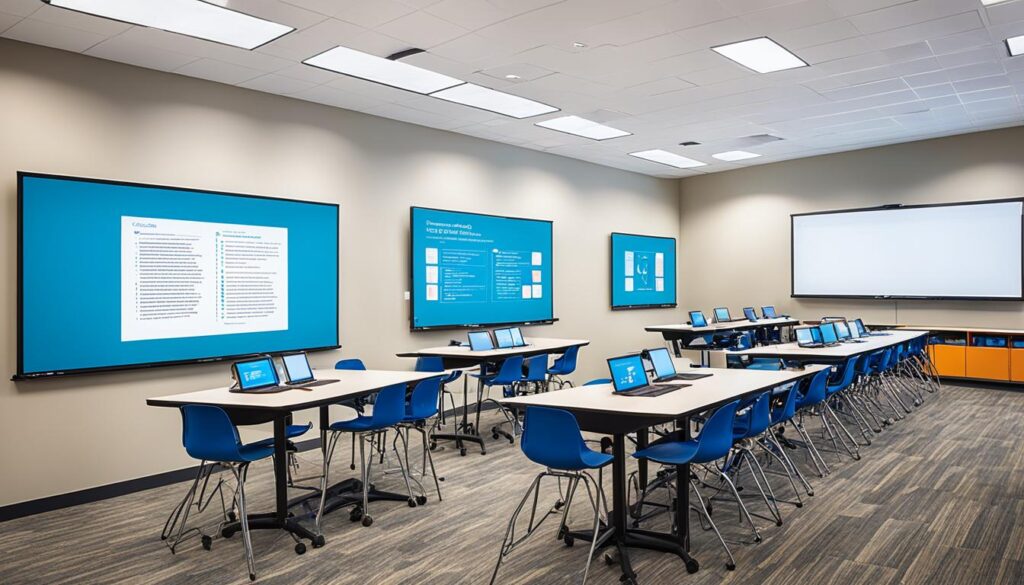
Integrating Instructional Technologies in Program Review
When conducting a program unit review, it is essential to incorporate the evaluation of instructional technology integration. This holistic approach ensures that technology-related needs are identified and addressed in order to enhance the overall effectiveness of the educational programs.
“Integrating instructional technologies in program review allows us to assess the impact of technology on student learning outcomes and make informed decisions for improvement,” says Dr. Jane Mitchell, Director of Curriculum Development at Greenfield University.
By evaluating the integration of instructional technologies, institutions can determine the extent to which these technologies facilitate student engagement, collaboration, and interactive learning experiences. Through this process, faculty members can receive valuable feedback on their use of technology, identify areas for improvement, and further develop their instructional practices.
- Assessment of Current Technology Integration: The program review should include an assessment of the current state of instructional technology integration within each academic department. This evaluation can be based on metrics such as the utilization of technology tools, the alignment of technology use with learning objectives, and the availability of technical support for faculty and students.
- Identification of Technology Needs: Based on the assessment findings, institutions can identify specific technology needs for each program or department. This includes determining whether additional training, resources, or infrastructure are required to support effective integration.
- Allocation of Funding: Adequate funding should be allocated to support the integration and adoption of instructional technologies. This ensures that the identified technology needs can be fulfilled and that faculty and students have access to the necessary resources. Funding can be obtained through a variety of channels, including grants, institutional budgets, and partnerships with industry.
Integrating instructional technologies in program review is a proactive approach to ensure that faculty, students, and programs are equipped with the necessary tools for success. It fosters a culture of innovation and continuous improvement, leading to enhanced student learning outcomes and overall program effectiveness.
| Benefits | Examples |
|---|---|
| Enhanced student engagement | Use of interactive online platforms, gamification of learning materials |
| Facilitated collaboration | Video conferencing tools, collaborative project management platforms |
| Improved accessibility | Screen reader compatibility, closed captioning options |
| Increased efficiency | Automated grading systems, online submission platforms |
Case Study: Effective Integration of Instructional Technology in Program Review at Greenfield University
Greenfield University, a leading institution known for its innovative approach to education, has successfully integrated instructional technologies into its program review process. By prioritizing the use of technology, the university has witnessed significant improvements in student engagement and learning outcomes.
“Our program review now includes a comprehensive evaluation of technology integration, enabling us to identify areas where technology can augment student learning and support faculty in delivering effective instruction,” explains Dr. Mitchell.
The university leverages a variety of instructional technologies, such as learning management systems, virtual laboratories, and multimedia resources, to enhance the learning experience across various programs. This integration has resulted in improved collaboration among students, increased accessibility for learners with diverse needs, and more efficient assessment and feedback processes.
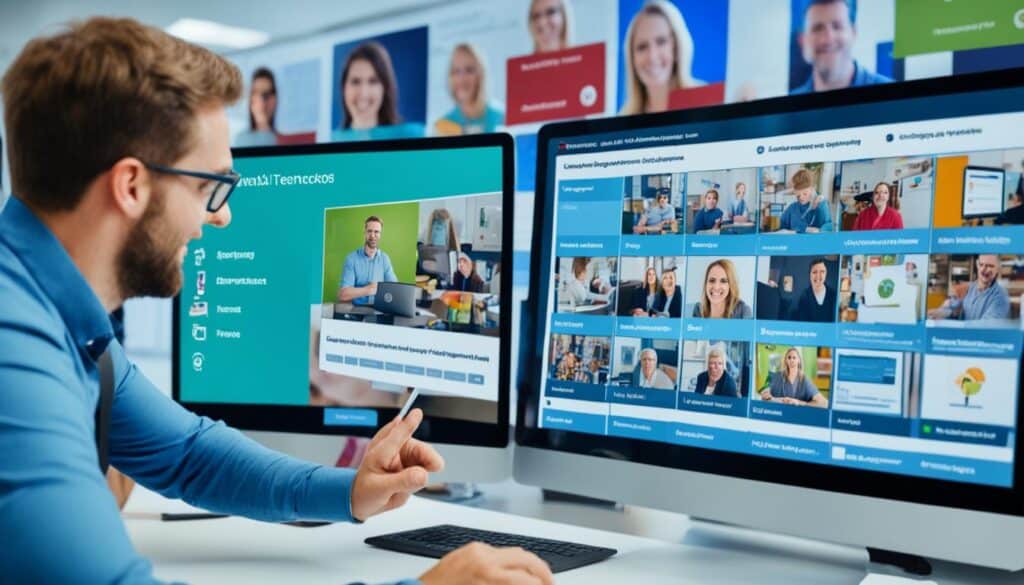
Through the strategic integration of instructional technologies in program review, institutions can ensure that faculty and students have access to the tools and resources needed to thrive in the digital age. By allocating the necessary funding and developing a comprehensive technology integration plan, institutions can pave the way for a successful future of education.
Providing Effective Professional Development Support
Professional development plays a crucial role in equipping faculty with the necessary skills and knowledge to effectively utilize smart classroom technologies and enhance student engagement. A comprehensive approach to professional development should encompass training on both the operational aspects of these technologies and the pedagogical strategies for their successful integration in the classroom.
Operational Aspects:
By offering training on the operational aspects of smart classroom technologies, faculty can gain confidence in using these tools effectively. Workshops and hands-on sessions can cover topics such as:
- Learning management system (LMS) navigation
- Content creation and management within the LMS
- Utilizing audiovisual equipment for interactive presentations
- Integration of multimedia resources
- Engaging students through interactive polls and quizzes
Pedagogical Strategies:
Alongside operational training, faculty should receive guidance on how to leverage smart classroom technologies to enhance student engagement and promote effective learning. Professional development sessions can include:
- Exploring pedagogical approaches that align with smart classroom technologies
- Designing interactive activities and assessments
- Creating collaborative online spaces for student engagement
- Implementing flipped classroom models
- Adapting teaching strategies to accommodate diverse student needs
By adopting a two-tier professional development approach, institutions can provide comprehensive support to faculty members. This approach addresses not only the technical aspects of using smart classroom technologies but also the pedagogical strategies required to effectively engage students and promote meaningful learning experiences.
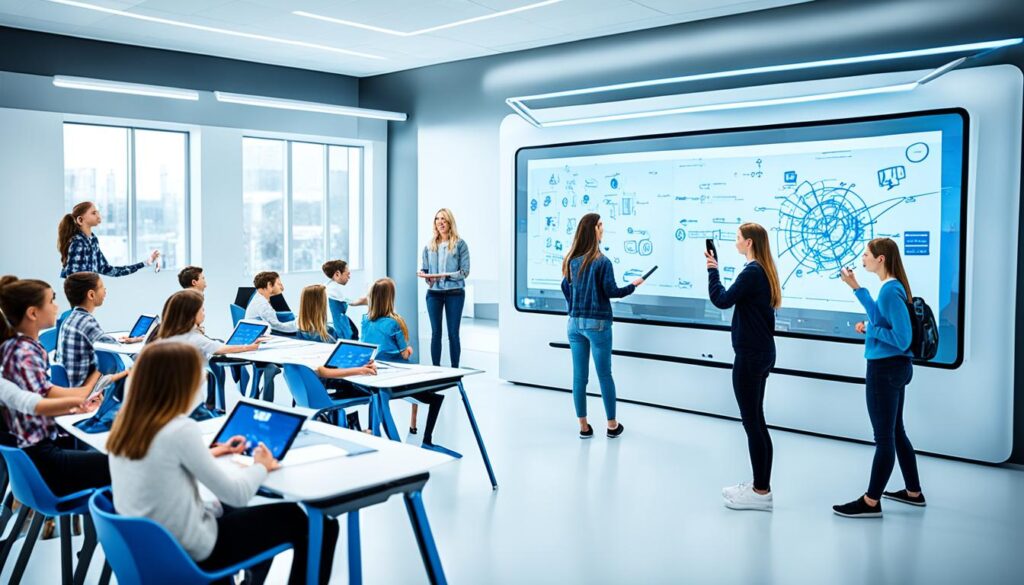
| Benefits of Effective Professional Development | Faculty Impact | Student Impact |
|---|---|---|
| Enhanced technology proficiency | Increased confidence in using smart classroom technologies | Improved student perception of faculty’s technological competence |
| Enhanced teaching and learning strategies | Adoption of innovative instructional techniques | Increased student engagement and active participation |
| Promotes collaboration and knowledge-sharing | Opportunities to exchange best practices with colleagues | Enhanced peer collaboration and student-to-student interaction |
Recognizing and Rewarding Faculty Adoption of Technologies
Faculty play a crucial role in integrating technology into education and creating innovative learning experiences for students. To encourage and recognize their efforts, institutions should implement faculty incentives, stipends, and technology exploration funding.
Stipends: Providing financial incentives such as stipends can be an effective way to reward faculty for adopting and utilizing technologies in their instruction. These stipends can serve as a tangible acknowledgment of their commitment to enhancing student learning through technology.
Awards and Recognition: Recognizing faculty for their exceptional use of technology can also motivate and inspire others to explore and adopt innovative teaching methods. Award programs that highlight faculty achievements in integrating technology can showcase best practices and encourage faculty to embrace new pedagogical approaches.
Integration into Annual Evaluations: To ensure that technology integration is valued and considered in faculty performance assessments, it can be integrated into the annual evaluation process. Including technology-related criteria in evaluations emphasizes the institution’s commitment to leveraging technology in education.
Technology Exploration Funding: Institutions should allocate funding specifically for technology exploration, encouraging faculty to experiment with emerging technologies and innovative teaching practices. This funding can support faculty-led research and development projects that explore the potential of technology in enhancing student engagement and learning outcomes.
Example of Faculty Incentive Program:
The table below outlines an example of a faculty incentive program that rewards faculty for their adoption and successful use of technologies in their instruction:
| Incentive Type | Description |
|——————-|——————————————————————|
| Stipends | Monetary rewards for faculty who integrate technology in courses |
| Awards | Recognition for exemplary use of technology in teaching |
| Integration | Consideration of technology integration in annual evaluations |
| Technology Grants | Funding for faculty-led technology exploration projects |

By implementing faculty incentives, stipends, and technology exploration funding, institutions can create a supportive and rewarding environment that fosters faculty adoption of technologies. These initiatives not only acknowledge and appreciate faculty efforts but also promote a culture of innovation and continuous improvement in teaching and learning.
Including Instructional Technologies in the Strategic Plan
To emphasize the commitment to technology integration, it is essential for institutions to include instructional technologies in their strategic plan. By doing so, the institution demonstrates a forward-thinking approach and prioritizes the integration of technology into various aspects of teaching and learning.
This strategic planning process ensures that there is institutional buy-in and institutional commitment to technology initiatives. It provides a clear roadmap for the implementation and sustainability of instructional technologies, with dedicated resources and funding allocated to support these initiatives.
By including instructional technologies in the strategic plan, institutions can effectively align their goals and initiatives with the evolving needs of faculty, students, and the broader educational landscape. This comprehensive approach ensures that technology integration is not seen as an isolated endeavor but rather as an integral part of the institution’s overall vision and mission.
“Strategic planning is not just about creating a vision; it’s about aligning resources and effectively implementing initiatives. Including instructional technologies in the strategic plan is a testament to the institution’s commitment to leveraging technology for enhanced teaching and learning.”
Benefits of Including Instructional Technologies in the Strategic Plan
Including instructional technologies in the strategic plan provides several benefits:
- Clear direction: It clarifies the institution’s vision for technology integration and sets clear goals and objectives.
- Allocation of resources: It ensures that funding is allocated for technology initiatives, enabling their successful implementation and sustainability.
- Faculty and student support: It establishes a framework for providing faculty and students with the necessary training, resources, and support to effectively integrate and utilize instructional technologies.
- Collaboration and coordination: It promotes collaboration and coordination among departments and stakeholders, facilitating the seamless integration of instructional technologies across the institution.
- Evaluation and assessment: It allows for the ongoing evaluation and assessment of technology initiatives, ensuring their alignment with institutional goals and desired outcomes.
By including instructional technologies in the strategic plan, institutions demonstrate their institutional commitment to technology integration and make a significant investment in the future of education.

The image above represents the institution’s commitment to instructional technologies, which is reflected in its strategic plan.
Sustaining Funding for Technology Initiatives
Technology initiatives should not be treated as one-time projects but require dedicated and recurring funding. As technologies evolve and faculty and student needs change, funding should be available for technology refresh and support. Long-term funding ensures the relevance of the curriculum and the success of students.
Investing in Long-Term Success
The integration of technology in education is an ongoing process that requires sustained investment. Without adequate long-term funding, institutions risk falling behind in meeting evolving needs and maintaining an innovative learning environment.
One key aspect of sustaining funding for technology initiatives is budgeting for regular technology refresh. As technology advances rapidly, outdated devices and software can hinder effective teaching and learning. By allocating funds for regular updates and replacements, institutions can ensure that faculty and students have access to the latest tools and resources.
Additionally, long-term funding allows for the continuous support and maintenance of technology infrastructure. This includes the availability of robust internet connectivity, software licenses, and technical support services. By proactively addressing technology-related issues, institutions can prevent disruptions and promote seamless integration of technology into the teaching and learning process.
Planning for Future Needs
An important consideration in sustaining funding for technology initiatives is anticipating and responding to evolving needs. As educational practices continue to evolve, new technologies and tools may emerge that better support student success. Long-term funding enables institutions to stay at the forefront of technological advancements and adapt their strategies accordingly.
Furthermore, a proactive approach to funding ensures that resources are available to explore and implement emerging technologies. Whether it’s virtual reality for immersive learning experiences or artificial intelligence for personalized instruction, having dedicated funding allows institutions to pilot and adopt innovative solutions that enhance student engagement and outcomes.
Also Read : Exploring the Future of Technology in Healthcare
The Role of Strategic Partnerships
Strategic partnerships can also play a crucial role in sustaining funding for technology initiatives. Collaborating with industry partners, government agencies, and philanthropic organizations can provide additional resources and funding opportunities. By leveraging these partnerships, institutions can secure grants, sponsorships, and donations that support the integration and ongoing development of technology in education.
Furthermore, forming partnerships with technology vendors can result in cost-effective solutions and discounts for hardware, software, and support services. These collaborations can help stretch the allocated funding further while ensuring access to quality technology resources.
Tracking and Accountability
Finally, sustaining funding for technology initiatives requires effective tracking and accountability measures. Institutions should establish clear processes for monitoring the utilization of funds and evaluating the impact of technology investments. By regularly assessing the outcomes and benefits of technology initiatives, institutions can make informed decisions about future funding priorities.
Table: Funding Allocation for Technology Initiatives
| Funding Source | Percentage Allocation |
|---|---|
| Institutional Budget | 50% |
| Grants & Scholarships | 25% |
| Strategic Partnerships | 15% |
| Donations & Fundraising | 10% |
By diversifying funding sources and ensuring transparency in financial management, institutions can create a sustainable model for supporting technology initiatives and driving student success.
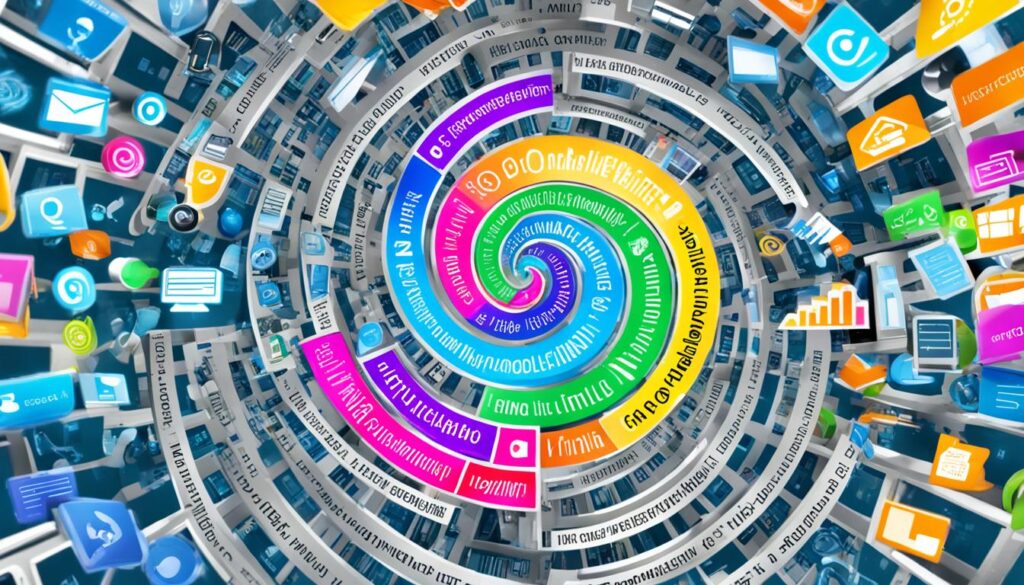
Conclusion
Integrating technology in education is a powerful way to empower students and create student-centered learning environments. By leveraging technology, we can personalize learning experiences, providing students with tailored educational opportunities that meet their individual needs and interests. Furthermore, technology gives students access to a wealth of information, enabling them to explore diverse subjects and expand their knowledge beyond the boundaries of traditional textbooks.
Technology also fosters interactive learning experiences, encouraging students to actively engage with the material through multimedia content, simulations, and virtual laboratories. This hands-on approach enhances their understanding and retention of concepts, making learning more enjoyable and impactful.
In addition, technology facilitates communication and collaboration among students and teachers, breaking down geographical and time barriers. Students can connect with peers and experts from around the world, exchanging ideas, collaborating on projects, and gaining valuable insights. This collaborative approach fosters critical thinking, teamwork, and problem-solving skills, essential for success in the 21st century.
Furthermore, technology development helps in developing digital literacy and skills, enabling students to navigate and evaluate information critically. In an increasingly digital world, these skills are essential for students to become active participants, responsible consumers, and ethical contributors to the society. Moreover, technology promotes accessibility and inclusivity, providing tools and resources to support students with diverse learning needs, ensuring that no one is left behind.
As we look ahead, it is clear that technology will play an even greater role in shaping the future of education. By embracing technology and creating student-centered learning environments, we empower the next generation with the skills, knowledge, and mindset they need to thrive in an ever-evolving world.
FAQ
Q: What is online education?
A: Online education refers to the method of learning using online platforms, websites, or applications instead of traditional in-person classroom settings.
Q: How do learning technologies enhance online education?
A: Learning technologies such as interactive tools, virtual reality, and online platforms enhance online education by providing an engaging and interactive learning experience for students and faculty.
Q: Why should institutions embrace online learning?
A: Institutions should embrace online learning to adapt to the current educational trends, meet student demands, and provide accessible and flexible learning options.
Q: What is the role of the metaverse in online education?
A: The metaverse offers immersive and interactive environments that can revolutionize the online learning experience by providing new ways for students to engage with course content and interact with instructors.
Q: How can educators adopt new technologies for online education?
A: Educators can adopt new technologies for online education by exploring innovative tools and approaches to enhance the online learning experience and provide students with a more interactive and engaging learning environment.
Q: What are students looking for in their online learning experience?
A: Students want online education to be accessible, engaging, interactive, and easy to use, with tools and approaches that cater to their learning preferences and provide them with valuable learning materials.
Q: How has the adoption of online learning changed due to the pandemic?
A: The pandemic has accelerated the adoption of online learning, causing institutions to shift towards online and hybrid learning models to ensure continuity in education and provide students with accessible and flexible learning options.
